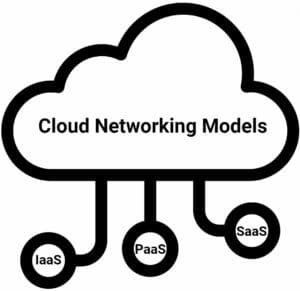In today’s rapidly evolving digital landscape, over 90% of enterprises are harnessing the power of cloud network technology. This game-changing innovation is revolutionizing how businesses and individuals manage their digital assets and applications. No longer confined to on-premises infrastructure, organizations worldwide are leveraging the cloud for its diverse benefits, from cost savings to advanced security.
As we emphasize the significance of security in cloud networking, it’s crucial to acknowledge the role of reliable tools that enhance digital protection.
NordVPN, a leading VPN service, offers an additional layer of security, especially vital in the era of remote work and distributed digital resources.
Whether you’re a business leader, an IT professional, or just a tech enthusiast, this blog post is crafted for you.
We’ll delve into the core components of cloud networking, illustrating its advantages through real-world examples, such as how it enabled remote work during the global pandemic.
From exploring various deployment models to discussing security best practices, we’ll cover the essential aspects that make cloud networking a pivotal element in our digital ecosystem.
By the end of this journey, you’ll gain a comprehensive understanding of this transformative technology.
Are you ready to explore how cloud network technology is reshaping our digital future? Let’s embark on this fascinating journey together!
Demystifying Cloud Network Technology: The Engine of Modern Computing
Cloud network technology has rapidly ascended as a beacon of advancement in modern computing, empowering businesses and individuals with unprecedented efficiency and productivity. But what exactly propels this technology to the forefront of our digital epoch?
In this comprehensive exploration, we will dissect the essence of cloud networking and illuminate its key components. Our aim is to furnish you with a robust understanding of this revolutionary innovation.
What is Cloud Networking?
At its core, cloud networking, or cloud-based networking, represents a synergistic blend of traditional networking principles with the expansive capabilities of cloud computing services. This avant-garde approach to networking involves designing, implementing, and managing network resources and services hosted in cloud environments.
This paradigm shift permits users to access, store, and process data and applications via the Internet, bypassing the constraints of physical servers and networking hardware traditionally maintained on-site.
Tracing the Trajectory: History and Evolution
Cloud network technology’s lineage dates back to the infancy of the Internet, where the notion of communal computing resources first germinated.
Its journey is marked by pivotal developments, such as the advent of virtualization in the early 2000s, the emergence of Amazon Web Services (AWS) in 2006, followed by Microsoft Azure and Google Cloud. These milestones have catalyzed the relentless refinement and diversification of cloud networking, solidifying its role as a linchpin in contemporary business operations.
The Five Pillars of Cloud Networking
To truly grasp cloud network technology, it’s essential to recognize its foundational elements:
- Data Centers: These are the physical hubs where cloud service providers host the necessary hardware that powers cloud infrastructure.
- Virtualization: This technology creates multiple virtual layers over physical computing resources, enhancing resource allocation and efficiency.
- Cloud Management Platforms: These software frameworks allow for meticulous monitoring, management, and optimization of cloud network resources.
- Networking Services: This category encompasses various services like VPNs, firewalls, and load balancers, ensuring secure and robust connectivity within the cloud.
- Application Programming Interfaces (APIs): These are the building blocks that enable developers to craft applications that seamlessly integrate and interact with cloud infrastructure.
By delving into these critical components, you gain a deeper perspective of cloud network technology’s intricacies and capabilities, paving the way for strategic implementation and effective utilization in your digital endeavors.
Leveraging the Power of Cloud Network Technology: A Catalyst for Transformation
The rise of cloud network technology has revolutionized the landscape of digital infrastructure, providing a suite of advantages that surpass the capabilities of traditional, on-premises solutions. Let’s dissect the key benefits that make cloud networking an indispensable asset for modern enterprises.
Scalability and Flexibility: The Agile Backbone of Business
Cloud network technology stands out for its remarkable scalability. Organizations can swiftly adapt their IT resources to align with fluctuating demands, ensuring efficiency and avoiding excess expenditure. This flexibility is pivotal for maintaining agility in today’s volatile market environment.
Cost Efficiency: A Smart Financial Shift
Transitioning to cloud networking marks a shift from capital expenses to operational ones. The pay-as-you-go model negates hefty initial investments and ongoing maintenance costs, presenting a financially prudent approach that aligns with contemporary business dynamics.
Security and Compliance: Your Digital Fortress
Top-tier cloud service providers are dedicated to safeguarding data with cutting-edge security protocols, including encryption and intrusion detection systems. Compliance with regulatory standards like HIPAA and GDPR is also streamlined, assuring businesses of robust data protection mechanisms.
Collaboration and Accessibility: Uniting Teams Anytime, Anywhere
The cloud is the enabler of boundless collaboration. With tools that allow real-time editing and sharing, remote and distributed teams can operate as cohesively as if they were in the same room, fostering a culture of synergy and co-creation.
Environmental Sustainability: Commitment to a Greener Future
Cloud networks embrace environmental responsibility by optimizing resource usage and reducing the carbon footprint of IT operations. Businesses that integrate cloud solutions not only gain operational benefits but also contribute to a sustainable future.
The superiority of cloud network technology is clear, paving the way for enhanced operational efficiency, cost savings, and competitive edge. By harnessing these advantages, organizations are well-positioned to propel their digital transformation and thrive in the new age of computing.
Navigating Cloud Networking Models: Tailoring Your Cloud Experience
Choosing the right cloud networking model is akin to selecting the perfect gears for a well-oiled machine. Each model is crafted to fit distinct business scenarios and technical demands. Let’s navigate through the three principal cloud networking models—IaaS, PaaS, and SaaS—and how they can revolutionize your digital strategy.
Infrastructure as a Service (IaaS): The Building Blocks of the Cloud
IaaS stands as the foundational layer in the cloud services hierarchy, providing you with the raw materials—virtual servers, storage, and networks. It’s akin to leasing a plot of land, then designing and constructing your building. AWS, Microsoft Azure, and GCP are akin to premium real estate developers in this space.
Pivotal Advantages of IaaS:
- Customizable resource allocation to match your business scale dynamically.
- Reduction in expenditures linked to hardware acquisition and upkeep.
- Freedom from the intricacies of physical hardware management, letting you focus on innovation.
Platform as a Service (PaaS): The Developer’s Canvas
PaaS goes a step further, offering not just the land but also the tools and blueprints necessary to create your architectural masterpiece. It’s the go-to model for developers seeking a conducive environment for application creation, testing, and deployment. Platforms like Heroku, Google App Engine, and Azure App Service equip developers with a rich toolbox for modern app development.
Core Benefits of PaaS:
- Accelerated app development cycle with pre-built tools and frameworks.
- Hassle-free environment management, allowing developers to concentrate on coding.
- Seamless integration and continuous delivery capabilities that foster agile development practices.
Software as a Service (SaaS): Effortless Software Utilization
SaaS delivers a complete, move-in-ready office space within the cloud. It’s the most encompassing model, presenting full-fledged applications just a click away. Services such as Salesforce, Office 365, and Google Workspace are prime examples of SaaS offerings that cater to a wide array of business operations.
Key Perks of SaaS:
- Instant software access with zero installation, directly enhancing productivity.
- Substantial cost savings by cutting down on license management and software upgrades.
- Regular, automatic updates ensuring your business stays ahead with the latest features.
Choosing Your Ideal Model
In essence, IaaS is the preferred choice for those desiring maximum flexibility and control over their virtual infrastructure. PaaS serves as a sanctuary for developers aiming to create without the burden of environment setup. SaaS emerges as the solution for businesses wanting comprehensive applications at their fingertips, with minimal fuss over maintenance.
Deciphering the distinctions among IaaS, PaaS, and SaaS will empower you to make an informed decision, aligning your cloud strategy with business priorities and technological requisites. It’s about finding the perfect fit for your enterprise to thrive in the cloud ecosystem.
Fortifying the Cloud: Strategies for Impeccable Network Security and Data Integrity
In the digital arena where cloud network technology is a cornerstone for operations, safeguarding sensitive data and mission-critical applications isn’t just an option—it’s a necessity. Let’s navigate through the labyrinth of security threats and emerge with best practices that fortify your cloud against the myriad of risks.
Navigating the Threat Landscape: Identifying Potential Hazards
The cloud’s expanse is not without its shadows. Recognizing the threats is the first step to defense:
- Data breaches: A breach can cascade into a torrent of issues, from identity theft to financial loss.
- Insider threats: The enemy within, whether through malice or mishap, can wreak as much havoc as any external adversary.
- Account hijacking: Credentials in the wrong hands can turn the keys of your cloud kingdom over to invaders.
- Denial of Service (DoS) attacks: These barrages can cripple the functionality and availability of cloud services.
- Insecure APIs: The very conduits that enable your cloud to function can also serve as pathways for peril.
Shielding Your Assets: A Blueprint for Robust Cloud Security
To parry the thrusts of these threats, a shield of best practices is essential:
- Ironclad Access Controls: Fortify your gates with multi-factor authentication, role-based access, and stringent privilege parameters.
- Data Encryption: Cloak your data in a veil of cryptography, both at rest and in transit, with robust encryption protocols.
- Vigilant Monitoring: Keep a watchful eye on your digital dominion by scrutinizing logs for signs of siege.
- Backup Battalions: Regularly reinforce your lines with backups, ensuring that you can swiftly recover and rally should disaster strike.
- Continuous Security Assessments: Test your ramparts with vulnerability assessments and penetration testing to find and fortify potential weak spots.
Cryptography in the Cloud: Locking Away the Secrets
Encryption is the sorcery of security, transmuting your data into unreadable enigmas to those without the key. Employ:
- Symmetric encryption for a swift and stalwart guard, suitable for vast quantities of data.
- Asymmetric encryption for a more intricate lock, with separate keys for sealing and unveiling secrets.
- Tokenization for a crafty disguise, substituting precious data with innocuous placeholders.
Regulatory Vigilance: Upholding Standards and Trust
The cloud doesn’t float above the law. Adherence to regulations like GDPR, HIPAA, and PCI DSS isn’t just about compliance—it’s about maintaining the trust of those you serve.
Arming your cloud environment with these robust security measures and adhering to regulatory standards will cement the integrity of your network and the trust of your stakeholders, ensuring that your cloud operations are both secure and resilient.
Charting the Horizon: Innovations Steering Cloud Networking’s Tomorrow
The trajectory of cloud network technology is not just onward; it’s upward, with innovations continually reshaping its landscape. This section illuminates the cutting-edge advancements poised to redefine our interaction with cloud ecosystems.
The Synergy of Edge Computing and Cloud Networks
Edge computing emerges at the frontier, pushing computational power to the data’s origin, slashing latency, and turbocharging cloud application performance. This fusion of edge and cloud ushers in an era of instant analytics and application responsiveness, tailor-made for sectors reliant on speed and agility, from the IoT frontier to the gaming universe and the burgeoning realm of autonomous transport.
AI and ML: The New Architects of Cloud Efficiency
Artificial Intelligence and Machine Learning meld into cloud networking as architects of a smarter infrastructure. AI’s prowess in automating intricate cloud management tasks—such as resource distribution, load forecasting, and security oversight—translates to heightened efficiency and scaled-back operational costs. Meanwhile, ML’s keen analytics unlock deep insights into user conduct and network efficiency, equipping enterprises with the foresight to refine their cloud approaches.
Serverless Computing: Elevating Developers to Cloud Nine
Serverless computing, or FaaS, unveils a realm where infrastructure concerns dissipate, allowing developers to ascend, focusing on crafting and deploying code. This paradigm shift entrusts the cloud service providers with the infrastructural reins, enabling swifter app evolution, precision resource use, and heightened cost-effectiveness.
5G: The Quintessence of Connectivity
The ascendancy of 5G heralds a new epoch of connectivity, synergizing with cloud networking to birth a nexus of uninterrupted communication. This union promises to amplify innovations in augmented reality, the Internet of Things, and instantaneous data analytics, setting the stage for transformative industrial and societal shifts.
In the dance of technological progress, these advancements are the lead, guiding cloud networking into a future brimming with promise and potential. Understanding and embracing these trends is not just prescient—it’s paramount.
**Stay tuned for more insights and deep dives into the latest advancements by visiting Top 5 Networking Technologies in 2024. Uncover the future-facing technologies that are set to redefine networking as we know it. Don’t miss out on the opportunity to be at the forefront of the digital revolution. Click through and continue your journey into the next generation of network technology. Your digital transformation awaits.**
Conclusion
The advent of cloud network technology has been nothing short of a revolution, fundamentally reshaping our digital interactions. It has emerged as a beacon of adaptability, scale, and economic intelligence.
Through this exploration, we’ve demystified the vital components and manifold benefits of cloud networking, laying out a blueprint for those eager to leverage its expansive capabilities.
Amidst this digital metamorphosis, vigilance in security and data integrity remains paramount. A steadfast commitment to the latest protective measures ensures that our ventures into the cloud are not only innovative but also secure.
The horizon of cloud networking is dynamic, with continuous innovation at its core. Organizations that embrace this perpetual evolution will not just survive but thrive, seizing the boundless prospects carved out by this groundbreaking force.
To remain at the vanguard of this digital renaissance, informed and strategic choices in cloud networking are key. By doing so, we not only spark innovation and operational excellence but also secure a decisive competitive advantage.
Dive deeper into the intricacies of network technology and chart your path to digital excellence. Explore further to stay ahead in the ever-expanding realm of network technology.
Reference :
- Samir Abdulnour, Ing., M.Sc.A – Author
- This article was written with the help of an AI language model, ChatGPT. Although the template generated the initial content, it was extensively reviewed, edited, and checked by the author to ensure accuracy and compliance with Google guidelines. The author takes full responsibility for the final product.










